- Visitors
- Researchers
- Students
- Community
- Information for the tourist
- Hours and fees
- How to get?
- Visitor Regulations
- Virtual tours
- Classic route
- Mystical route
- Specialized route
- Site museum
- Know the town
- Cultural Spaces
- Cao Museum
- Huaca Cao Viejo
- Huaca Prieta
- Huaca Cortada
- Ceremonial Well
- Walls
- Play at home
- Puzzle
- Trivia
- Memorize
- Crosswords
- Alphabet soup
- Crafts
- Pac-Man Moche
- Workshops and Inventory
- Micro-workshops
- Collections inventory
Students
Students
Huaca Prieta
Background and recent research work
Jose Alva y Augusto Bazán
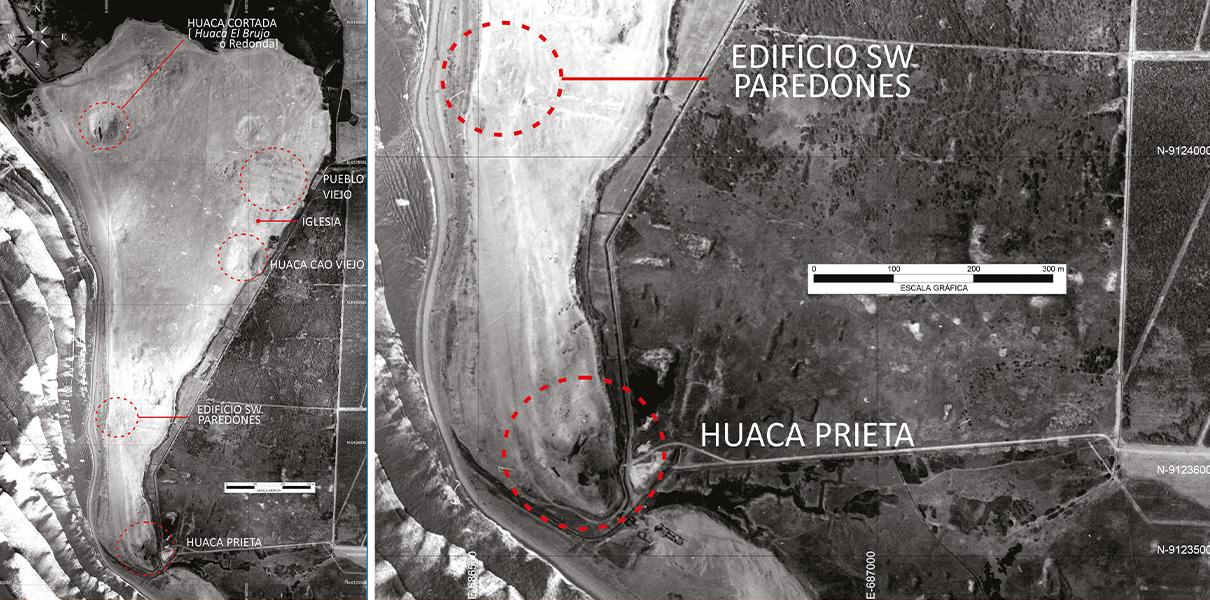
The El Brujo Archaeological Complex houses the vestiges of a neat social history that dates back approximately 14,000 years before the present, being one of the few settlements in the Andes that shows a continuous cultural occupation.
The Huaca Prieta, located at the southern end of the complex, is the archaeological testimony of greatest notoriety in the literature and is a reference in the beginnings of the process of social complexity in the Central Andes.
The also known Huaca Negra, according to Kroeber, is an oval mound constructed with cobble stones joined with waste or garbage, composed of ash and organic remains, which give the building a dark color and for which it gets its name.
The first known reports of Huaca Prieta were generated by Antonio Raimondi, Italian naturalist, in 1868. In its passage through the El Brujo Archaeological Complex, Raimondi states that the Huaca had the appearance of being a “natural hill” surrounded by several saline lagoons that produced little salt.
In 1926, Alfred L. Kroeber, American anthropologist, together with Julio C. Tello, the father of Peruvian archeology, visited the mound and reported the presence of the big carved gash, currently visible, made by raiders on top of the ashen monument. Said gash revealed the remains of elaborated architecture based on cobble stones and a high density of waste throughout the composition of the pre-Hispanic building. It should be noted that Kroeber does not identify when the Huaca Prieta was built, because apparently he was not sure of the fragments of eroded ceramic he found in the gash, whose presence was probably due to the removal of late contexts.
Map of the El Brujo Archaeological Complex and its main architectural components.
Junius Bird examining textile and botanical remains recovered from his excavations. “Bird and Hyslop 1985: figure 7”.
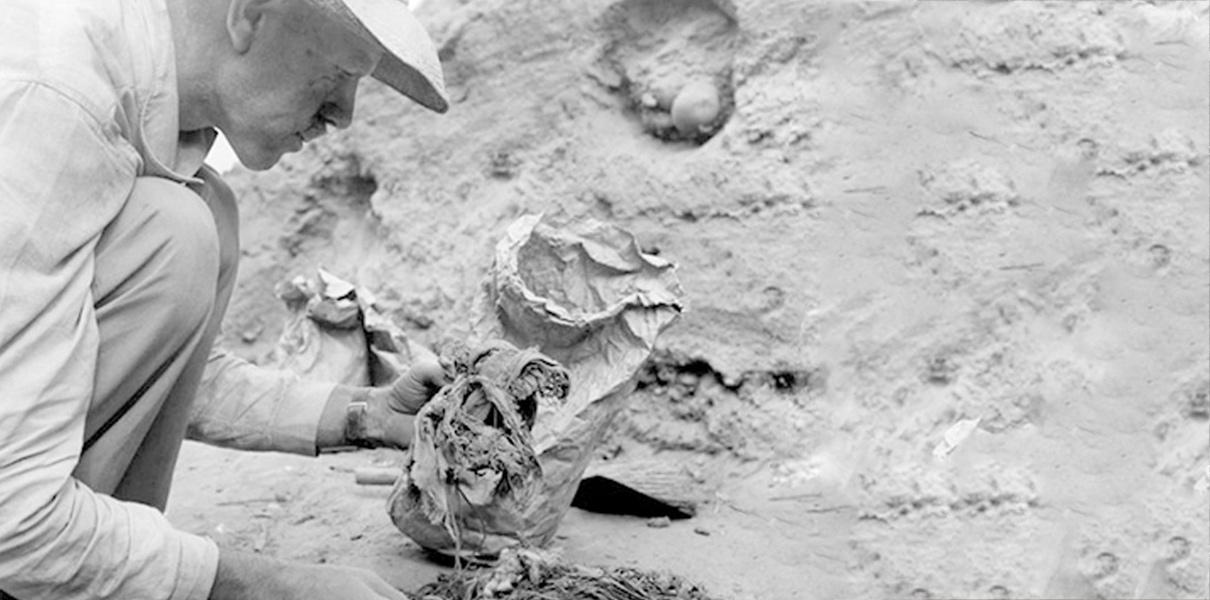
Junius Bird, in the framework of the Virú Project of 1946, carried out the first scientific excavations in the Huaca in order to delve into the knowledge of the ways of life prior to the appearance of ceramics in the Peruvian Andes. At that time, there were only five pre-ceramic sites that were known on the coast, and Huaca Prieta was the best to understand the use of different coastal ecosystems due to its location near the sea and the mouth of the Chicama river.
Junius Bird's excavations revealed a series of underground chambers lined with cobble stones, which were used as houses by the ancient inhabitants. Inside these houses and outside the retaining walls of the Huaca Prieta, the burials of groups of individuals placed in a flexed position were found. One of them had as paraphernalia two pyrographed calabashes with depictions of felines and birds, as well as cotton textiles with geometric designs. These artifacts, along with others, soon became references of technical skill and references of pre-Chavin figurative art.
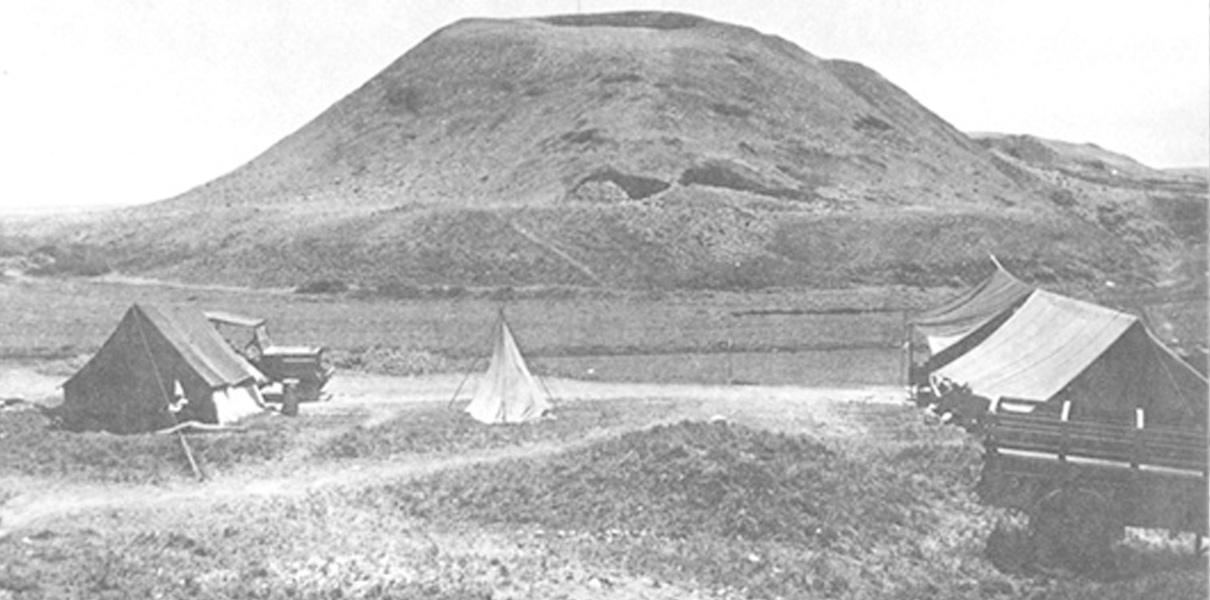
The radiocarbonic dates generated from the samples recovered from the deepest levels exposed by Junius Bird, defined that Huaca Prieta had an occupation that was approximately 5 thousand years old, thus placing it in the Late Archaic period (3000-1700 ANE). For Bird, the population of Huaca Prieta was not dense and their subsistence was based on the collection of mollusks, shellfish and wild plants. However, an incipient agriculture of achira, calabashes, beans, pepper, lucuma, tubers and cotton was also practiced; the latter provided the necessary fibers for the production of the characteristic decorated textiles.
More than half a century later, between 2006 and 2013, Tom Dillehay and Duccio Bonavia resumed research on the site, in an interdisciplinary effort focused on understanding the processes and dynamics that existed between human groups and ancient ecosystems in times of incipient agriculture.
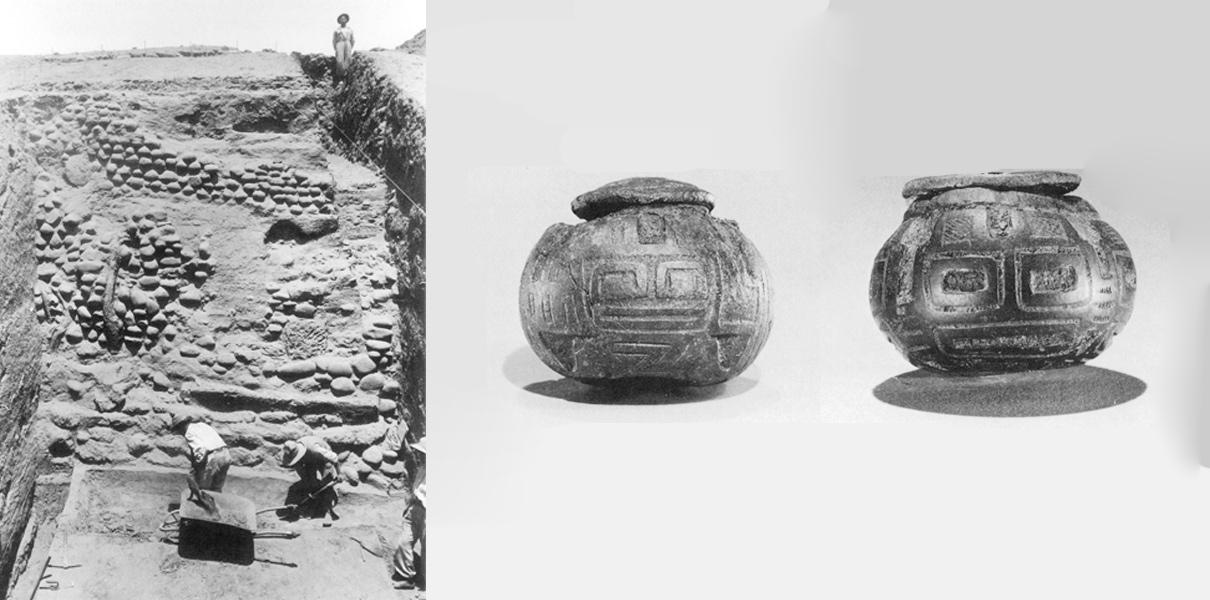
View of the Junius Bird camp located at the foot of the Huaca Prieta in 1946. Bird and Hyslop 1985: figure 1.
The identification of the five cultural phases that occurred in the southern area of the El Brujo Archaeological Complex, as well as their chronology, stands out from the latest research. Occupations much earlier than those registered early by Bird have been identified, that inhabited the sector even before the existence of the mound we see today, during the Late Pleistocene.
The first phase, called Pre-monticular Contexts, occurred between 12,550-5,622 ANE. It is so named because it is the human occupations developed before the construction of the Huaca Prieta. These contexts were found in the depths of the excavations of Dillehay and Bonavía, and therefore were difficult to identify and define because they were between 6 and 30 meters below the current surface of the mound.
The second phase, Incipient Monticular Construction, developed between 5,622-4,588 ANE, corresponds to the first efforts to form a building, or the first construction stage. Dillehay estimates that this first architectural component measured between 6 and 8 meters high, 25-30 meters wide and consisted of small clusters of pebbles or ground levels. This type of construction was extended, in a similar size, to other sectors of the current Huaca.
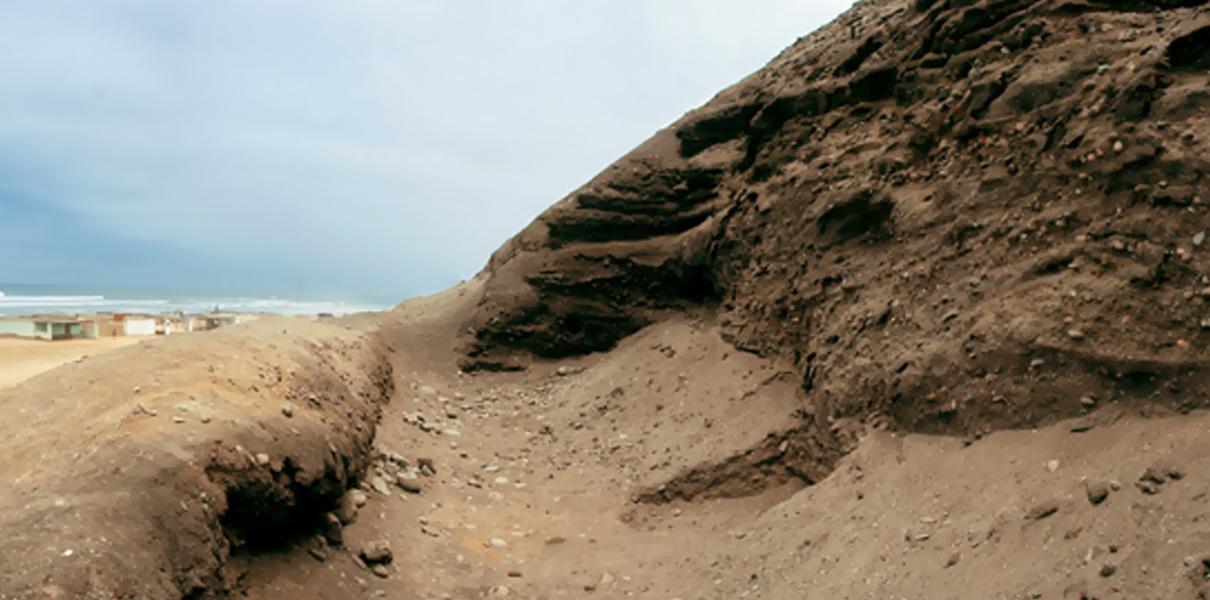
Image 01: View of the existing cobble stone walls on the north side of the Huaca Prieta. “Bird and Hyslop 1985: figure 21”.
Image 02: Gourds decorated with zoomorphic designs found in one of the funerary contexts of the Huaca Prieta. “Bird and Hyslop 1985: figure 42”.
Phases III and IV correspond to the expansion of the mound and the establishment of the architectural configuration that we see today. These two phases occur between 4,588-3,358 ANE and 3,358-2,157 ANE, respectively. Phase V, Termination, corresponds to the abandonment of the mound, associated with the deposition of funerary chambers and the abandonment of ritual practices, occurred between 2,157-1505 ANE. In these contexts intrusive evidence of later ceramic periods was found.
In this way, the occupational history of the Huaca Prieta now has better time parameters, which, understood together with the geological and weather environment also investigated by Dillehay and his team, allow us to understand the history of the early men and women of the Chicama Valley.
Bibliography
National General Archive. Republican Archive, Antonio Raimondi Collection, Travel to Trujillo. Chicama Valley – San Pedro de Guadalupe – Monsefú –Chiclayo – Lambayeque and Hacienda de Patapo (1868).
- Bennett, W y Bird, J. (1949). Andean Culture History. New York: The American Museum of Natural History.
- Bird, J. (1948). Preceramic Cultures in Chicama and Virú. Memoirs of the Society for American Archaeology, 4, 21-28.
- Bird, J. y Hyslop, J. (1985). The Preceramic Excavations at the Huaca Prieta, Chicama Valley, Peru. New York: The American Museum of Natural History.
- Dillehay, T., Bonavia, D., Goodbred, S., Pino, M., Vásquez, V., Rosales, T., Conklin, W., Splitstoser, J., Piperno, D., Iriarte, J., Grobman, A., Levi-Lazzaris, G., Moreira, D., López, M., Tung, T., Tielbaum, A., Verano, J., Adovasio, J., Scott Cummings, L., Bearéz, P., Dufour, E., Tombret, O., Ramirez, M., Beavins, R., DeSantis, L., Rey, I., Mink, P., Maggard, G., y Franco, T. (2012). Chronology, mound-building and environment at Huaca Prieta, coastal Peru, from 13 700 to 4000 years ago. Antiquity, 86, 48-70.
- Dillehay, T. (Ed.) (2017). Where the Land Meet the Sea. Fourteen Millennia of Human History at Huaca Prieta, Peru. Austin: University of Texas Press.
- Kaulicke, P. (1994). Los Orígenes de la Civilización Andina. Lima: Editorial Brasa S.A.
- Kroeber, A. L. (1930). Archaeological Explorations in Peru. Part II. The Northern Coast. Chicago: Field Museum of Natural History.
- Mujica, E. (Ed.) (2007). El Brujo. Huaca Cao, Centro Ceremonial Moche en el Valle de Chicama. Lima: Fundación Wiese.